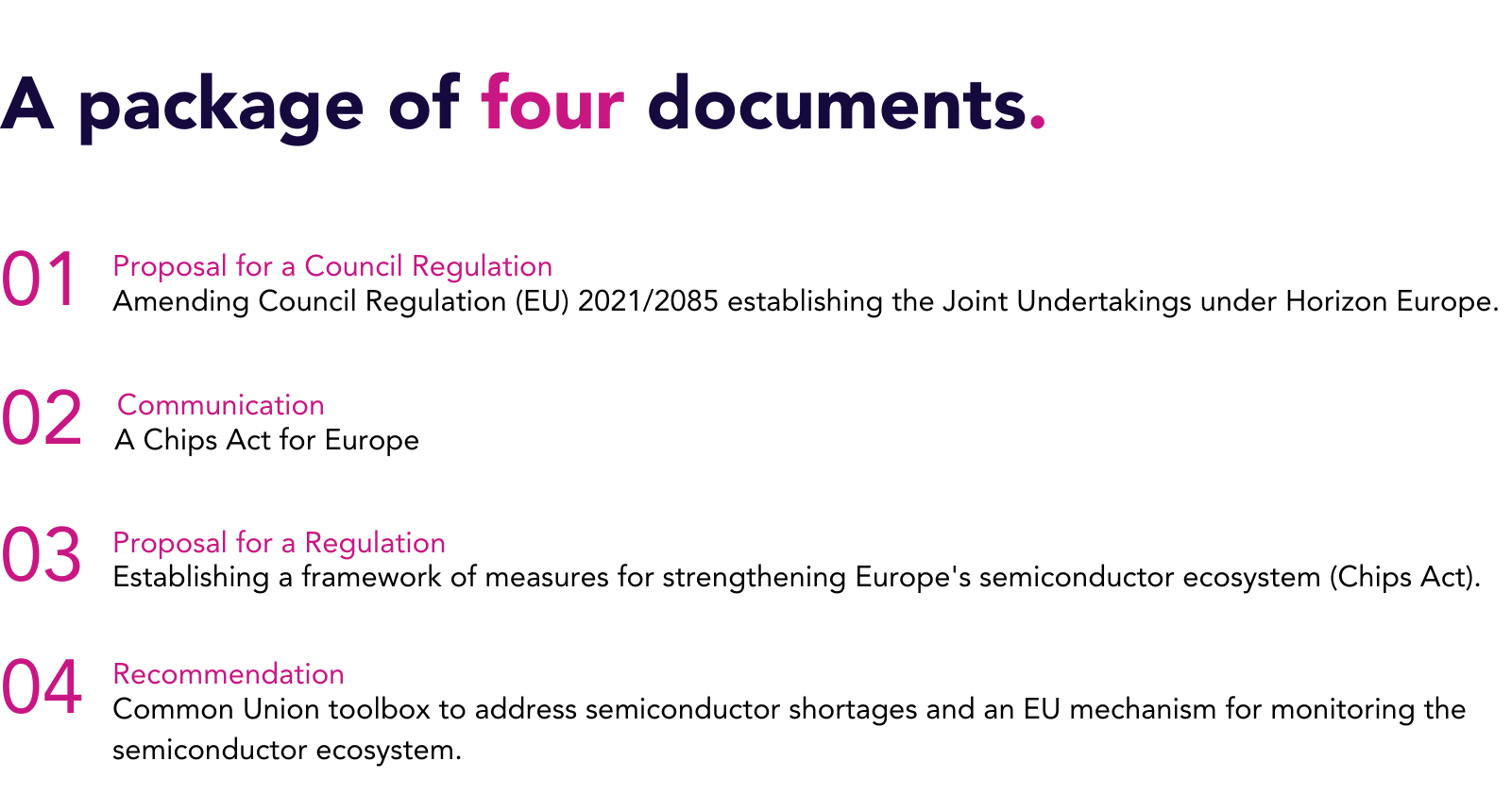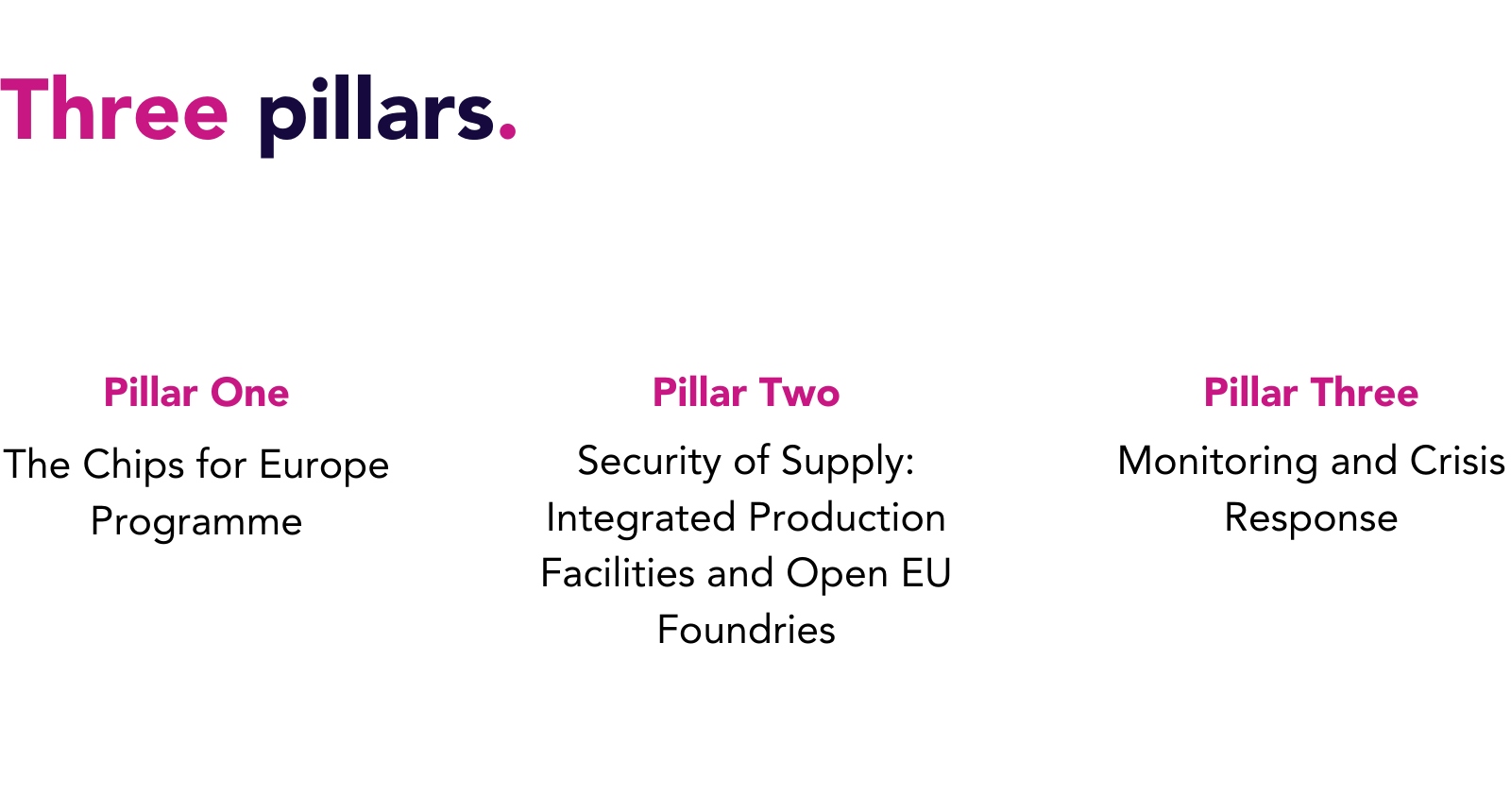The Chips Act is one of the long-awaited milestones of 2022. On 8 February 2022, the Commission published its strategy to accelerate the European Union’s capabilities in the production of semiconductors. The EU Chips Act aims at reaching at least 20% of world production in value of cutting-edge and sustainable semiconductors by 2030.

Proposal for a Regulation.
Establishing a framework of measures for strengthening Europe’s semiconductor ecosystem (Chips Act)
The Regulation establishes a framework, consisting of three pillars, for strengthening Europe’s semiconductor ecosystem.

Pillar One: The Chips for Europe Programme
The Chips for Europe Programme aims at reinforcing the Union’s competitiveness, resilience and innovation capacity.
The programme comprises five components:
- Design capacities for integrated semiconductor technologies;
- Pilot lines for production, and testing and experimentation facilities;
- Advanced technology and engineering capacities for accelerating the development of quantum chips;
- A network of Competence Centres and skills development;
- A Chips Fund for access to capital by start-ups, scale-ups and SMEs.
The Initiative shall be supported by funding from Horizon Europe and the Digital Europe Programme and implemented according to the Regulations establishing those programmes.
The Regulation provides for a procedural framework to facilitate combined funding from Member States, investment without prejudice with State aid rules, the Union budget and private investment. This will take the form of a new legal instrument the European Chips Infrastructure Consortium (ECIC), which can be used by legal entities to structure their collaborative work within a consortium.
Pillar Two: Security of Supply
The Act wants to secure supply by recognising Integrated Production Facilities or Open EU Foundries, these facilities shall be considered to contribute to the security of supply of semiconductors in the Union. The recognition of these sites is laid out in the text including a contribution to the security of supply and to a resilient ecosystem in the internal market but also they should have a clear positive impact on the semiconductor value chain in the Union.
Pillar Three: Monitoring and Crisis Response
Pillar three is about a mechanism to monitor the semiconductor value chain and to respond to disruptions of the supply of semiconductors in the internal market.
- Monitoring and alerting system: Member States shall provide to the Commission information for mapping factors, trends and events that could lead to significant disruptions of the global semiconductor value chain with repercussions in the EU (Union risk assessment).
- Semiconductor crisis stage:
- The Commission can activate the crisis stage through an implementing act when there is concrete, serious, and reliable evidence of a semiconductor crisis.
- The Commission may request organisations of undertakings, or individual undertakings operating along the semiconductor supply chain for information to assess the semiconductor crisis and identify potential mitigation measures. These entities are obliged to provide the Commission with the requested information.
- The Commission may also oblige semiconductor manufacturing facilities or undertakings along the semiconductor supply chain to accept and prioritise the production of crisis-relevant products for critical sectors. Upon the request of two or more Member States, the Commission may, on their behalf, act as a central purchasing body to procure crisis relevant products for critical sectors.
Governance: the European Semiconductor Board
At EU level, the proposal establishes a European Semiconductor Board, composed of representatives from the Member States and chaired by the Commission.
The European Semiconductor Board will:
- provide advice on the Initiative to the Public Authorities Board of the Chips Joint Undertaking (pillar 1);
- provide advice and assistance to the Commission in order to exchange information on the functioning of the IPF and OEF (pillar 2);
- discuss and prepare the identification of specific critical sectors and technologies, address monitoring and crisis response issues (pillar 3), and provide support in the consistent application of the proposed Regulation and facilitate cooperation among Member States.
At national level, Member States will designate one or more national competent authorities and, among them, a national single point of contact for the purpose of implementing the Regulation.
Recommendation.
Common Union toolbox to address semiconductor shortages and an EU mechanism for monitoring the semiconductor ecosystem
The Recommendation accompanies the proposed Regulation as a tool to enable a rapid and coordinated response to the current shortage. To that end, it proposes to set up a coordination mechanism to decide on crisis response measures. It also includes measures for coordinated monitoring of the semiconductor value chain.
The Commission has set up the European Semiconductor Expert Group for the purpose of implementing this Recommendation. It will serve as a platform for coordination between Member States and provide assistance to the Commission in the implementation of the forthcoming Regulation.
Once the Regulation enters into force, this Recommendation may be repealed.
Next Steps .
Member States are encouraged to immediately start coordination efforts in line with the Recommendation to understand the current state of the semiconductor value chain across the EU, to anticipate potential disturbances and take corrective measures to overcome the current shortage until the Regulation is adopted.
The European Parliament and the Member States will discuss the Commission’s proposal for a Regulation on a European Chips Act in the ordinary legislative procedure.
When adopted, the Regulation will be directly applicable across the EU.